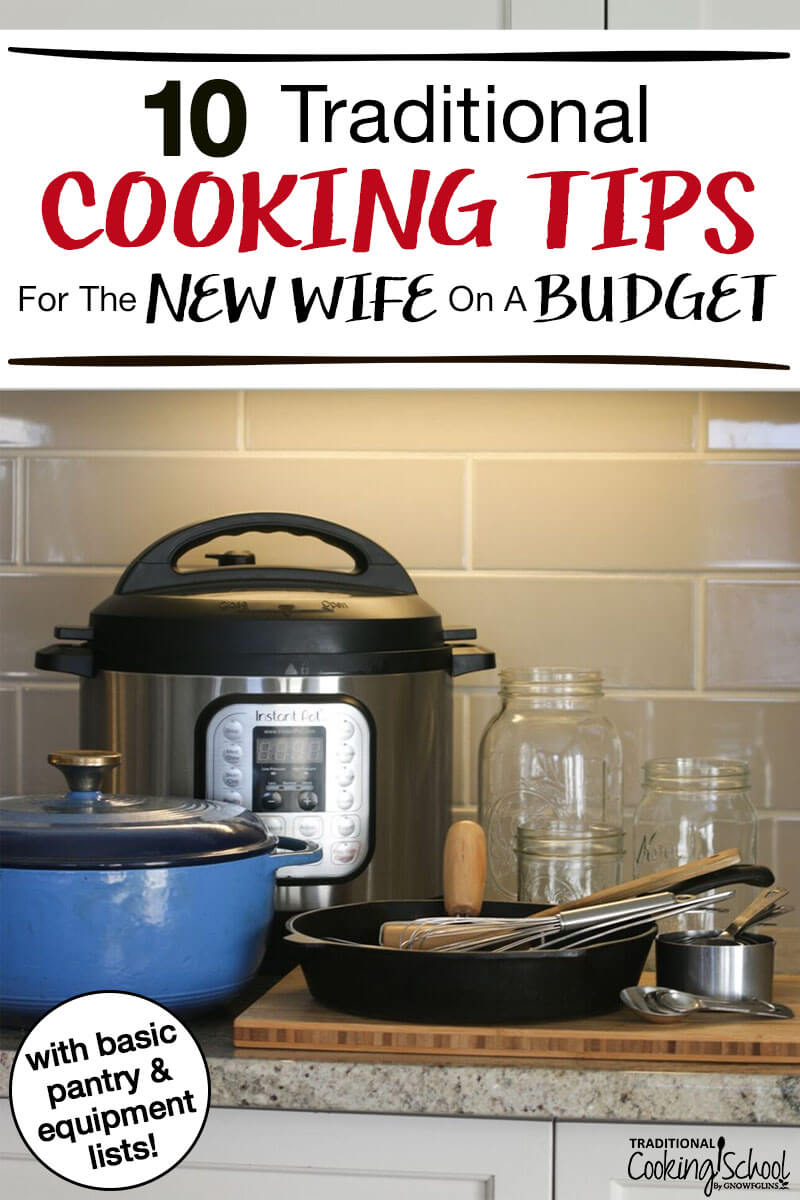
In my family, December is wedding time!
My husband and I celebrate our anniversary this month, and so do both sets of our parents!
In the last three years of marriage, I’ve learned a lot about how to cook traditional foods for a new and/or growing family.
If you’re a new wife or bride-to-be, this post is for you! Traditional cooking doesn’t have to be overwhelming, even if you’ve never thought about sourdough, meal planning, or the best kind of water filter before. 😉
10 Traditional Cooking Tips For The New Wife On A Budget
This is THE new wife’s guide to traditional cooking on a budget! If you’ve never managed a real foods kitchen before, look no further!
#1 — Get Your Fiancé Or Husband Involved
Even if you’re going to be doing most of the cooking, it’s so important that BOTH of you are on the same page. Maybe he doesn’t yet understand the difference between pastured and organic (maybe you don’t either!)… but that’s okay! Does he support what you’re trying to do? Is he committed to a healthy lifestyle? Will he try new foods with an open mind, even if he doesn’t like them at first or at all? Those are the things that matter.
If you need more help with this step, check out…
#2 — Make A Budget & Stick To It
This is also something to talk about with your significant other. Go over your finances together and talk about a reasonable amount to set aside for food each month.
Then, if you want to go even more in-depth (believe me, it’s helpful), make a plan for exactly how you’ll spend that food money. What portion of it will go towards bulk items? What portion towards meat? How about fresh produce? Having these amounts in mind throughout the month will be helpful as you do your shopping.
Here are more resources:
#3 — Save Money Where You Can
Shop around for the best prices on different foods. In addition to taking stock of the grocery stores in your area, check out any local farms. Produce from a farmers market can often be expensive, but sometimes you can find a local farmer selling a particular food for cheap. For instance, I recently found organic pastured eggs from a local farmer in the Boise, Idaho area that are the same price as organic eggs from Costco. This is the first time I can afford to buy local organic eggs, and I’m stoked! 🙂
Buy in bulk. This isn’t always cheaper, but there are often deals for buying in larger quantities. Azure Standard is a great option if they ship to your area.
Make not buy. Things like bread, yogurt, granola, and breakfast cereal are all cheaper to make yourself. Of course, this requires a commitment of time, but do consider this if you’re penny pinching. Anything you make yourself will likely be healthier, too.
Buy cheap, less nutritious foods but maximize their nutrition via traditional preparation methods. For instance, if you can’t afford raw milk in your area, buy pasteurized whole milk from the grocery store and culture it into probiotic yogurt or kefir before consuming. Or, buy cheap whole wheat flour and use your sourdough starter to turn it into more nutritious and digestible baked goods like English muffins, sandwich bread, or chapatis.
Incorporate meatless meals. Meat, especially high-quality grass-fed, pastured, or wild-caught meat, is expensive. While high-quality meat is important (see why below) that doesn’t mean you have to eat it every meal or even every day. To mitigate the strain on your budget, consider substituting meat for other cheaper forms of protein a few times a week. For instance, taco bowls sans ground beef, omelets, or a veggie pizza all utilize yummy yet cheaper forms of protein (beans and rice, eggs, and cheese)! There are tons of delicious vegetarian-style dishes out there — give them a try!
Follow the Dirty Dozen/Clean Fifteen lists. Every year, the Environmental Working Group publishes lists of the twelve fruits and vegetables most contaminated by pesticides, and the fifteen fruits and vegetables least contaminated. If you can’t afford all organic produce, at least buy organic anything that falls on the Dirty Dozen list, and buy conventional the rest.
Reduce waste. Make an effort to know what’s in your fridge and pantry so food doesn’t go bad and end up in the garbage. Even better, start a composting system so food scraps don’t go in the trash at all!
Start a garden. Even a teensy windowsill herb garden is better than nothing. Anything you can grow yourself will save you money at the grocery store. Check out our gardening archives here for easy tutorials and how-to articles!
Think outside the box. How else can you save money, so you can prioritize the food budget? Maybe air-dry your clothes to save on electricity, or ditch disposables (paper towels, tissues, paper napkins) in favor of re-usables (cloth rags, real dishes, cloth napkins).
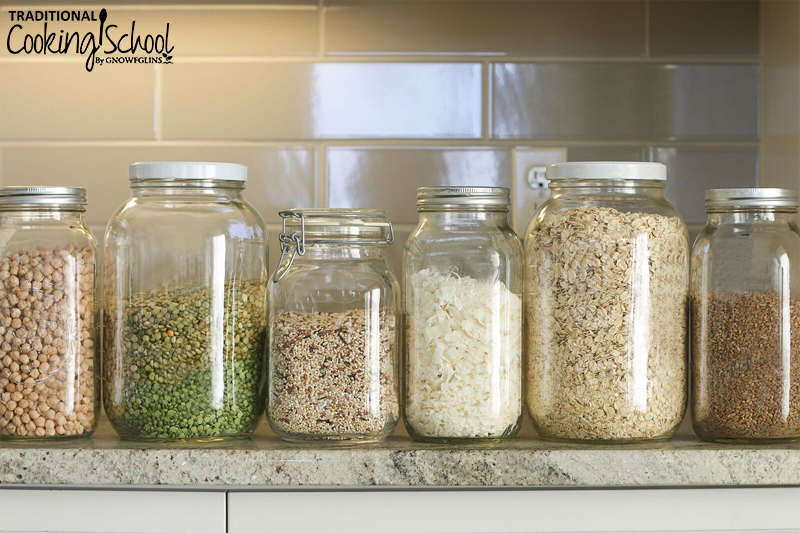
#4 — Build A Real Food Pantry
Assuming you’re new to traditional cooking or this is your first time living independently, it’s time to fill your real food pantry! Yet with what?
There are so many alternative, healthy pantry items available today. While it’s great to have options, unless you or a family member has a food allergy or sensitivity, there’s no need for five, six, or SEVEN different flours in your pantry! Keep it simple with only one or two foods for most categories. The less variety, the less money you’ll spend.
With that in mind, here are some pantry ideas for the real food new wife on a budget.
- grains: whole wheat flour, white rice, oats
- oils: butter, extra virgin olive oil
- seasonings and spices: sea salt, pepper, garlic powder, basil, parsley, oregano, cumin, smoked paprika, cinnamon, cocoa powder
- sweeteners: evaporated cane juice, honey or maple syrup, raisins
- legumes/beans: lentils, pinto beans
- proteins: organic chicken, grass-fed beef, wild-caught salmon, organic eggs, organic dairy*
- seasonal produce staples: potatoes, sweet potatoes, squashes, carrots, onions, tomatoes, cucumbers, etc.
- miscellaneous: raw apple cider vinegar, shredded coconut
*I’ve specifically marked proteins as organic, grass-fed, or wild-caught because spending your money on high-quality animal products will give you a cleaner diet than spending your money on high-quality plants. Why? Environmental contaminants accumulate as they ascend the food chain. Animals that eat plants are more toxic than the plants themselves. So if you’re going to prioritize and spend more money on a high-quality food, spend it on animal products.
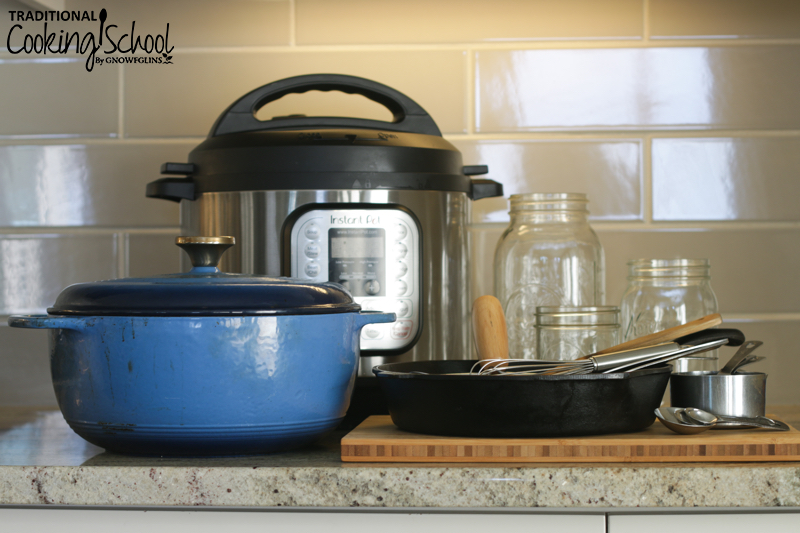
#5 — Build A Traditional Cooking Tool Kit
If you haven’t gotten married yet, it’s helpful to think about the tools you’ll need in your real food kitchen… before the big day! That way family and friends can help out.
However, if you weren’t able to plan ahead, never fear. Traditional cooking is about making do. After all, we’re going back to the basics and cooking the way our grandmothers did. 🙂
When building your traditional cooking tool kit — a.k.a. all the pots, pans, utensils, dishes, appliances, etc. you’ll need in your real food kitchen — try to keep it simple. Think natural materials that will last, practically brand-new, for the rest of your life: glass, stainless steel, wood, cast iron, and ceramic. Avoid toxic materials like plastic or Teflon that will degrade enough to lose functionality, but won’t deteriorate in a landfill.
Try to find items that fulfill multiple purposes. For instance, an Instant Pot that is yogurt maker, slow cooker, and pressure cooker all in one! Or, Mason jars that can be used not only for food storage (fridge and pantry), but drinking cups, containers for homemade salves, etc. as well.
Also, since you’re on a budget, shop secondhand! It may take some looking, but high-quality cooking tools can be found in thrift stores for super cheap. You’ll also save on sales tax!
Your kitchen toolkit may look slightly different than mine. Here are some ideas to get you started.
- set of stainless steel pots and pans
- 10-inch to 14-inch cast iron skillet
- Dutch oven
- utensils (spatula, ladle, serving/stirring spoon, wooden spoon, skimmer, whisk, cutlery, knives, measuring cups and spoons, veggie peeler, mesh strainer, pastry roller)
- cookie sheets
- loaf pans/cake pans
- mixing bowls
- cutting board
- Mason jars (gallon, half-gallon, quart, pint, and half-pint being the most helpful sizes)
- Vitamix (can be bought refurbished for cheaper)
- Instant Pot (to use as pressure cooker and slow cooker)
- Berkey water filter (because tap water is toxic!)
Curious what other real food cooks love? Check out these articles!
- My Top 10 Favorite Kitchen Gadgets
- 8 Eclectic, Fun, and Useful Kitchen Hand Tools
- How to Equip a Kitchen When You Start Out or Start Over
- 6 Lessons Learned From 2+ Years Of Pressure Cooking
#6 — Learn One Skill At A Time
By skill, I mean any one of the several traditional preparation methods:
- fermentation, such as sourdough, garlic-dill pickles, apple chutney, ginger beer, kombucha, water kefir, etc.
- culturing, such as milk kefir, yogurt, cultured butter, homemade cheese, etc.
- soaking, such as for grains, nuts, and seeds (featured in recipes like soaked rice, soaked scones, and soaked Irish soda bread)
- sprouting, such as for grains, legumes, etc.
- dehydrating, such as for soaked or sprouted foods that are ideally eaten dry
Traditional preparation methods serve to make certain foods more digestible and nutritious. They accomplish this either by neutralizing anti-nutrients (soaking, sprouting) and/or by maximizing the nutrients already there (fermenting, culturing).
If you’re new to traditional cooking, there’s no need to ferment, culture, soak, sprout, or dehydrate everything in sight all at once! Prioritize. Baby steps will get you where you want to go, even if you’re one busy lady (check out our tips for how to cook real food even if you’re busy here!). Which skill will most benefit you and your family? Or which skill interests you the most?
In my opinion, you will be most successful in learning these preparation methods without burning out IF you balance ease with interest. Pick something easy (like soaked rice — something you’ll likely already make often) where all that’s required is to combine the ingredients ahead of time so they can “soak” before cooking.
As you learn these easy skills, you can also slowly incorporate any of the more interesting ones that spark your fancy. Yogurt, for instance. Don’t get me wrong — yogurt isn’t hard to make! Yet it requires several more steps and less commonplace ingredients, so give it a try but don’t do too much, too fast.
Whatever you choose, pick a skill and master it, then move on to the next. And be sure to check out our eCourses for more in-depth information on all of these topics!
#7 — Make A Meal Plan
Let’s be honest — I’m not at all good at meal planning. My meal planning consists of forgetting to thaw meat until noon the day of, and then scrambling to the freezer before I forget again!
However, meal planning is worth the effort. If one will only plan ahead, meals can be more creative with less stress. Imagine sitting down to a steaming bowl of Pho instead of spaghetti for the third time that week — all because you thought ahead! Not that there’s anything wrong with spaghetti. 😉
Need some inspiration? Here are some recipe collections to help you get started!
- 35 Best Real Food Dinners On A Budget (+3 Tips For Frugal Meals!)
- 25+ Healthy Ground Beef Recipes For Easy Meals (Paleo, Whole30, Keto)
This leads me to my next point, because meal planning gets so much easier if you only…
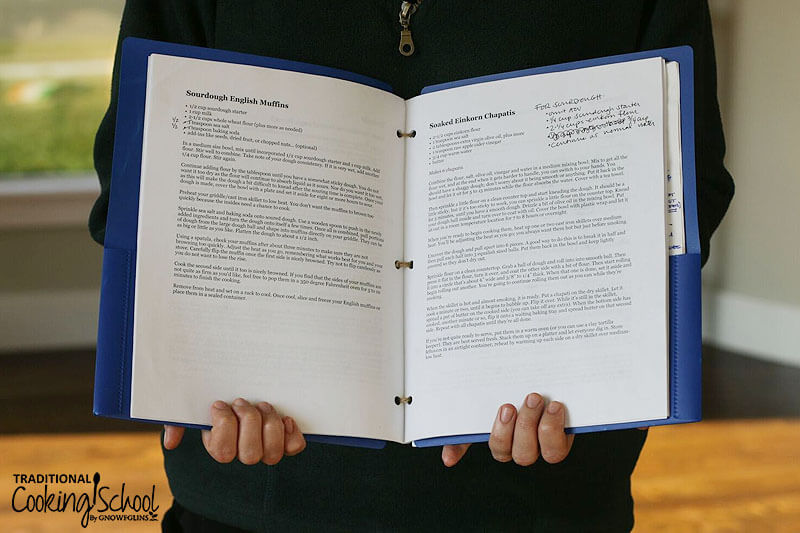
#8 — Make Yourself A Cookbook
There came a time when I had so many favorite recipes scattered across so many different blogs, cookbooks, and papers… that to start any given dish I had to spend a while searching for it first. That all changed the day I made my own personal cookbook. It’s nothing special — just a collection of my favorite recipes printed out and arranged in a folder. Yet, it makes cooking so much easier!
I encourage you to do the same. 🙂
Even if you don’t have very many favorite recipes in the beginning, make your own cookbook anyway. Maybe your mom makes a killer sourdough pizza, or your friend recently perfected her homemade ginger beer… if you love the recipes, add ’em to the book!
Need ideas? Here are some of my favorite menu staples!
- Soaked Muesli with Fresh, Local Fruit
- Sourdough Waffles With Fermented Strawberries & Yogurt Cheese
- Grain-Free Salmon Patties With Lemon Sour Cream
- 30-Minute Sausage & Sweet Potato Breakfast Hash (Whole30, Paleo)
- 4-Ingredient Rosemary Oven-Roasted Baby Potatoes (Paleo, Whole30)
- Homemade Sourdough Mediterranean Pizza (with ancient wheat einkorn!)
- Quinoa Tabbouleh
- Sourdough English Muffins
- Einkorn Sourdough Chapatis {Indian Flatbread}
- 5-Spice Apple Chutney {lacto-fermented!}
- Yes! Homemade Mayonnaise Is Easier Than Store-Bought!
- Perfect Southern Cornbread {in a blender!}
- Strawberry-Basil Switchel
#9 — Build A Real Food Medicine Cabinet
When I got married and moved to the city after living in the country for 10 years, I experienced about 5 months of getting sick a lot more frequently than I was used to — from several colds all the way to mono! I have a feeling it was my body adjusting to a new pace of life. Whatever the reason, I had to build a medicine cabinet from the ground up pretty quickly.
Food is medicine, right? For real food cooks, their pantry can double as a medicine cabinet. Consider keeping these healing foods on hand for colds, the flu, or any illness that comes your way.
- homemade broth to be made into healing soup
- raw apple cider vinegar
- echinacea herb to brew into tea (check out these other herbs, too!)
- raw honey to make into this easy cold-busting tonic
- raw garlic
- elderberry tincture
This excellent post addresses each of the above foods and more, with instructions on how to use them for best results. And remember, you’ll also have to ditch the foods compromising your immune system (like sugar) to really make the most of these simple real food remedies!
This isn’t food per se, but I also utilize essential oils. My favorites to use around the house are tea tree, lavender, peppermint, lemon, eucalyptus, and rosemary. Check out our essential oil archives for more ideas.
#10 — Build A Real Food Library
Finally, the best way to learn something is to fully immerse oneself in it. This requires commitment… and support from like-minded individuals who get it! Here are a few of my favorite resources (cookbooks and websites alike) when it comes to traditional cooking, so you can stay encouraged and inspired.
- Traditional Cooking School’s eBooks and recipe archives
- Nourishing Traditions by Sally Fallon-Morell
- Gut and Psychology Syndrome by Natasha Campbell-McBride
- The River Cottage Cookbook by Hugh Fearnley-Whittingstall
- Einkorn: Recipes For Nature’s Original Wheat by Carla Bartolucci (you don’t necessarily have to use einkorn flour!)
- Traditionally Fermented Foods by Shannon Stonger
- Ladled: Nourishing Soups For All Seasons by Kimberly Harris
- The DIY Pantry by Kresha Faber
- From Scratch: Easy Recipes For Traditionally Prepared Whole-Food Dishes by Shaye Elliott
- EatBeautiful.net
- AllTheNourishingThings.com
- ZeroWasteChef.com
Don’t already own the books? If you’re a new wife on a budget, ask around! Maybe your library or a local friend has a copy you can borrow. If not, many can be bought quite cheaply used.
That concludes our new wife’s guide to traditional cooking on a budget! Do you have any traditional cooking tips for the new wife?
...without giving up the foods you love or spending all day in the kitchen!

2 free books:
Eat God's Way
Ditch the Standard American Diet, get healthier & happier, and save money on groceries...
We only recommend products and services we wholeheartedly endorse. This post may contain special links through which we earn a small commission if you make a purchase (though your price is the same).


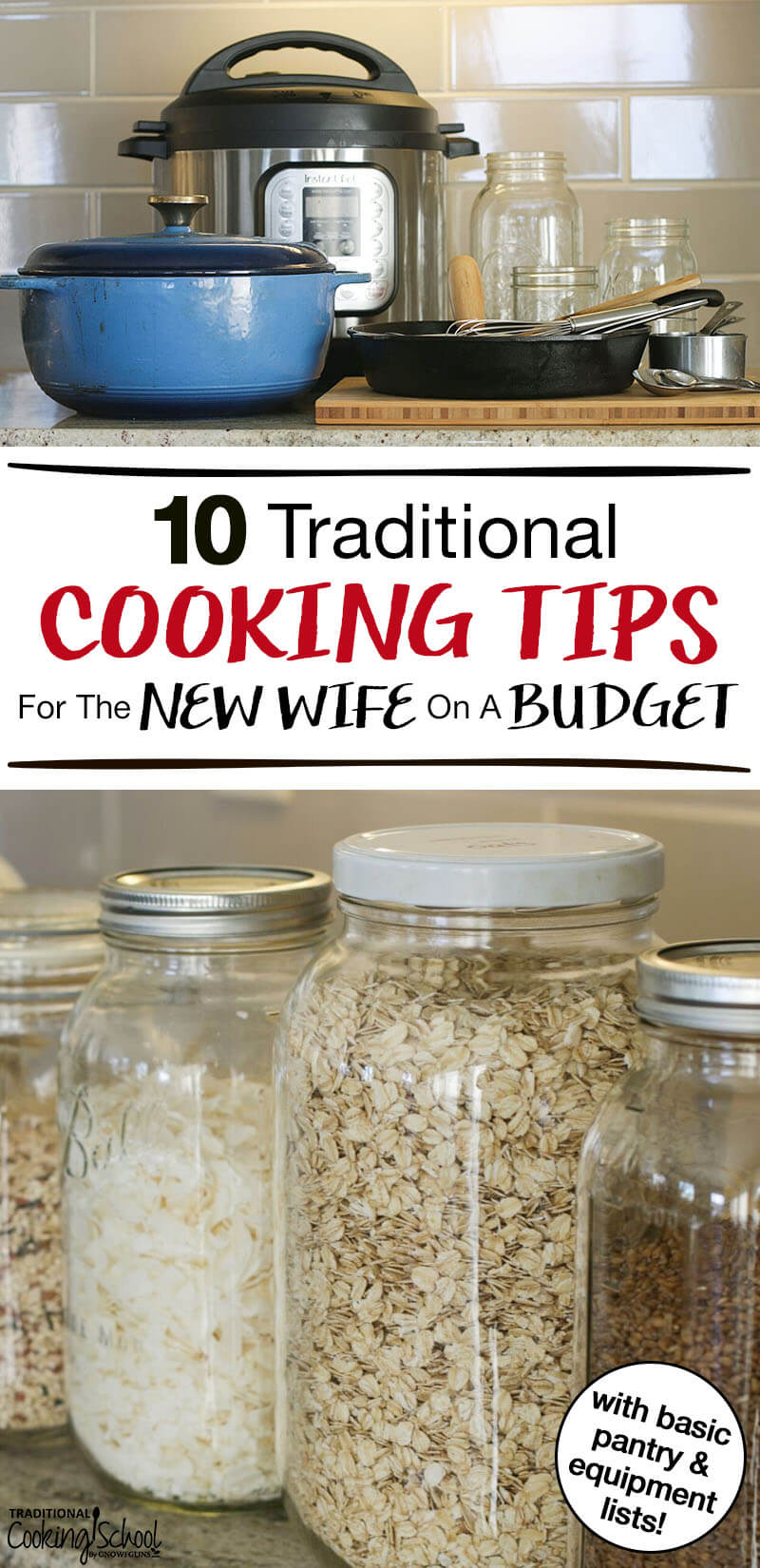
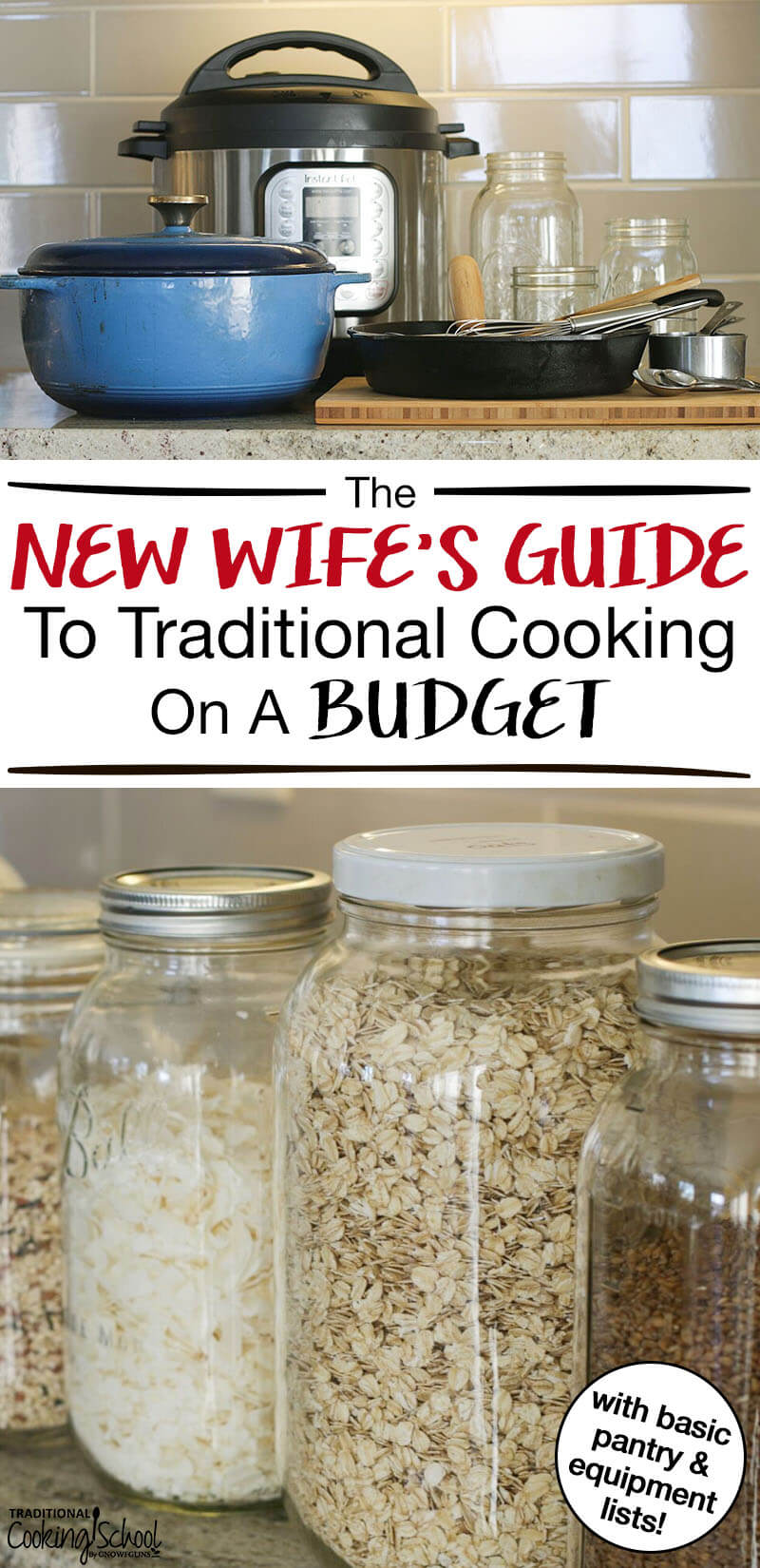
Love this article! What great advice from Haniya. Look at the wisdom passed down from mother to child all because of some health struggles that lead to education about food, body, nature. God is SO good! Think of how healthy our society would be if we all ‘taught’ our children how to live to be healthy.